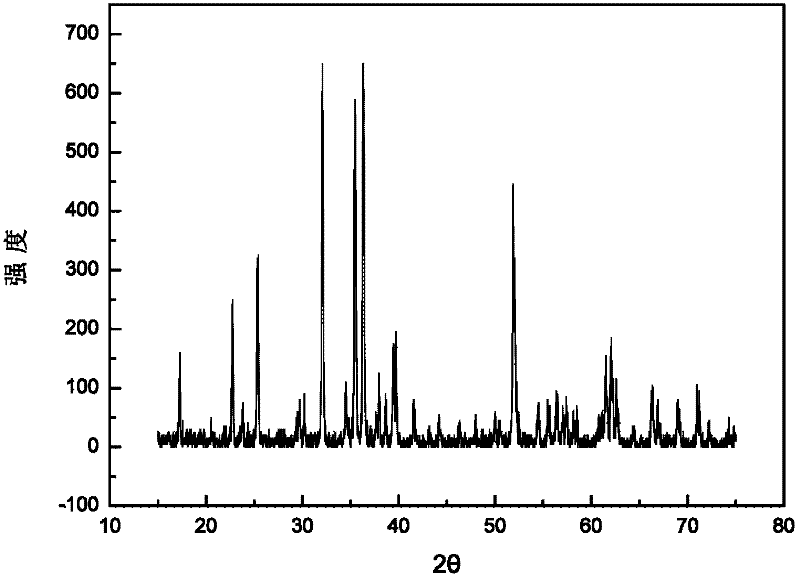Manufacture method of ferrosilite magnesium, and application in rechargeable magnesium cell anode material
An iron silicate, magnesium battery technology, applied in battery electrodes, chemical instruments and methods, circuits, etc., can solve the problems of unsatisfactory positive electrode and poor oxidation stability of rechargeable magnesium batteries, and achieve improved electrochemical activity, Lower synthesis cost and smaller particle size
- Summary
- Abstract
- Description
- Claims
- Application Information
AI Technical Summary
Problems solved by technology
Method used
Image
Examples
Embodiment 1
[0023] 0.6g of KCl, 0.0968g of MgO, 0.4354g of FeC 2 o 4 2H 2 O and 0.1452g of SiO 2 After grinding for 30 minutes until uniform, vacuum-dry at 100°C for 12 hours, then heat-treat at 350°C for 2 hours under the protective atmosphere of argon, then heat-treat at 900°C for 6 hours, and finally cool naturally to room temperature to obtain silicic acid iron magnesium.
[0024] The magnesium iron silicate prepared above was subjected to a powder X-ray diffraction experiment on a Rigaku D / MAX2200PC X-ray diffractometer produced by Shimadzu Corporation of Japan. The experimental conditions are as follows: copper target, X-ray wavelength 0.15406 nm, Ni filter; the light tube voltage used is 40kV, the current is 20mA, the scanning range is 15-75°, and the scanning speed is 4° min -1 .
[0025] Metal element detection was carried out on the Iris Advantage 1000 Inductively Coupled Plasma Optical Emission Spectrometer produced by the thermoelectric company produced above, and the res...
Embodiment 2
[0029] 0.6g of KCl, 0.0968g of MgO, 0.4354g of FeC 2 o 4 2H 2 O and 0.1452g of SiO 2 After grinding for 30 minutes until uniform, vacuum-dry at 100°C for 12 hours, then heat-treat at 350°C for 2 hours under a protective atmosphere of argon, then heat-treat at 1000°C for 6 hours, and finally cool naturally to room temperature to obtain silicic acid iron magnesium.
[0030] Metal element detection was carried out on the Iris Advantage 1000 Inductively Coupled Plasma Optical Emission Spectrometer produced by the thermoelectric company produced above, and the results showed that the molar ratio of Mg and Fe was 1:1.
[0031] The magnesium iron silicate prepared above was subjected to a powder X-ray diffraction experiment on a Rigaku D / MAX2200PC X-ray diffractometer produced by Shimadzu Corporation of Japan. The experimental conditions are as follows: copper target, X-ray wavelength 0.15406 nm, Ni filter; the light tube voltage used is 40kV, the current is 20mA, the scanning ra...
Embodiment 3
[0034] 0.6g of KCl, 0.0968g of MgO, 0.2878g of FeC 2 o 4 2H 2 O and 0.1202g of SiO 2 After grinding for 30 minutes until uniform, vacuum-dry at 100°C for 12 hours, then heat-treat at 350°C for 2 hours under a protective atmosphere of argon, then heat-treat at 1000°C for 6 hours, and finally cool naturally to room temperature to obtain silicic acid iron magnesium.
[0035] The magnesium iron silicate prepared above was subjected to a powder X-ray diffraction experiment on a Rigaku D / MAX2200PC X-ray diffractometer produced by Shimadzu Corporation of Japan. The experimental conditions are as follows: copper target, X-ray wavelength 0.15406 nm, Ni filter; the light tube voltage used is 40kV, the current is 20mA, the scanning range is 15-75°, and the scanning speed is 4° min -1 .
[0036] Metal element detection was carried out on the Iris Advantage 1000 inductively coupled plasma emission spectrometer produced by the thermoelectric company of the United States for the iron ma...
PUM
| Property | Measurement | Unit |
|---|---|---|
| particle diameter | aaaaa | aaaaa |
Abstract
Description
Claims
Application Information
 Login to View More
Login to View More - R&D
- Intellectual Property
- Life Sciences
- Materials
- Tech Scout
- Unparalleled Data Quality
- Higher Quality Content
- 60% Fewer Hallucinations
Browse by: Latest US Patents, China's latest patents, Technical Efficacy Thesaurus, Application Domain, Technology Topic, Popular Technical Reports.
© 2025 PatSnap. All rights reserved.Legal|Privacy policy|Modern Slavery Act Transparency Statement|Sitemap|About US| Contact US: help@patsnap.com



